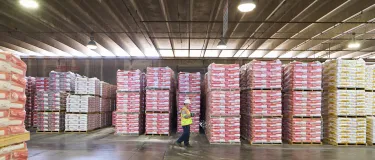What's in Your Mix Matters: Your Cement Questions Answered
Cements have been used in construction for thousands of years, and although the ingredients needed for portland cement haven't changed much the demands around concrete performance have changed significantly. New technologies, scheduling acceleration, resource constraints and design criteria have evolved over the years. To meet these demands, it’s important to understand how cement and supplementary cementitious materials can help you meet today’s performance needs.
That’s why Holcim US believes in providing our customers with technical expertise and services. From helping our customers meet challenging performance criteria to material testing, our technical experts are here to help take your mix to the next level.
Every year, our team meets with our sales teams to discuss hot topics in the cement and concrete industry, and this year our team touched on some of the most common questions that ready-mixed producers are asking throughout the country today. Here are some of the most popular questions, answered by our team of experts.
How does “hot cement” affect concrete?
By: Claude Bergeron, Technical Service Engineer, Holcim North Central Region
Occasionally during hot weather, some concrete producers may notice their portland cement temperatures increase. As cement clinker is pulverized in a grinding mill, energy in the form of heat is imparted into the finished cement. Consequently, cement plants which are not equipped with cooling systems may market cements with elevated temperatures. The American Concrete Institute (ACI) 225 reports that cement temperatures ranging between 90°F (32°C) and 170°F (77°C) may be utilized in concrete during hot weather. Therefore, the question may arise: How does “hot cement” affect concrete?
In fresh concrete, hot cement may result in a loss of concrete slump and perhaps a reduction in set time. Other than these two issues, experience has shown that elevated cement temperatures contribute very little to concrete in hot weather. ACI 305 recognizes that controlling the temperature of fresh concrete is important to avoid more significant issues in hot weather. ACI 305 specifies that the maximum temperature of concrete at the time of discharge shall be 95°F (35°C). This is because elevated concrete temperatures may cause increased water demand, an increase in plastic and thermal cracking, and difficulty in controlling entrained air contents; all which may lead to decreased strengths and durability issues just to name a few.
Since maintaining a favorable concrete temperature to overcome hot weather issues is paramount, the more appropriate question is: How does the temperature of various concrete materials affect the temperature of fresh concrete?
According to ACI 305, to reduce the temperature of concrete by 1°F (0.5°C) any of the following reductions need to be made:
- 8°F (4°C) reduction in cement temperature
- 4°F (2°C) reduction in water temperature, or
- 2°F (1°C) reduction in temperature of the aggregates.
This data concludes that aggregates contribute the most to the fresh concrete temperature. Therefore, reducing the temperature of the aggregates contributes the most to reducing the concrete temperature. Considering a soaker hose for the aggregates may be the simplest method to cool fresh concrete in hot weather. This graph represents the relative effect of each material on the concrete’s temperature assuming the other temperatures are held constant at 68°F (20°C).
When 28-day cube strengths drop, are concrete strengths also expected to drop?
By: Joe Clendenen, Technical Service Engineer, Holcim Midwest Region
In the production of ASTM C150 portland cement, the standard test for strength determination is the use of ASTM C109 mortar cubes, made with a fixed combination of the cement, standard graded sand, and water. These are then cured under highly controlled laboratory conditions. As a general rule, there is some correlation between ASTM C109 mortar cube strengths and ASTM C39 concrete strengths for a constant set of materials under similarly controlled conditions (Reference 1, Figure 1). For this reason, we closely monitor ASTM C109 results for strength trends and consistency.
It is important to note that there is some amount of difficulty in tying ASTM C109 mortar cube strengths to field data due to the inherent higher variability through effects such as temperature, production, other material variability, field mix adjustments, testing conditions, testing precision, etc., when evaluating shifts in field performance, it is important to take all potential factors into account.
While ASTM C109 mortar cubes can provide some useful information on strength performance for our customers, we believe that a more useful tool is the monitoring of strengths using concrete directly (Figure 1). At Holcim, we evaluate all plant portland cements routinely using a standard concrete mix under laboratory controlled conditions. As opposed to field data, this removes the influence of field conditions, allowing us to focus on changes in performance due to the cementitious material itself, while giving us a closer representation than ASTM C109 mortar cubes alone.

Have a question?
For more information on our technical services, or if you need guidance on your next project, please contact your local sales representative.
References:
ACI Committee 225, “Guide to the Selection and Use of Hydraulic Cements” (ACI 225R-16), American Concrete institute. Farmington Hills, MI
ACI Committee 305, “Guide to Hot Weather Concreting” (ACI 305R-10), American Concrete institute. Farmington Hills, MI






